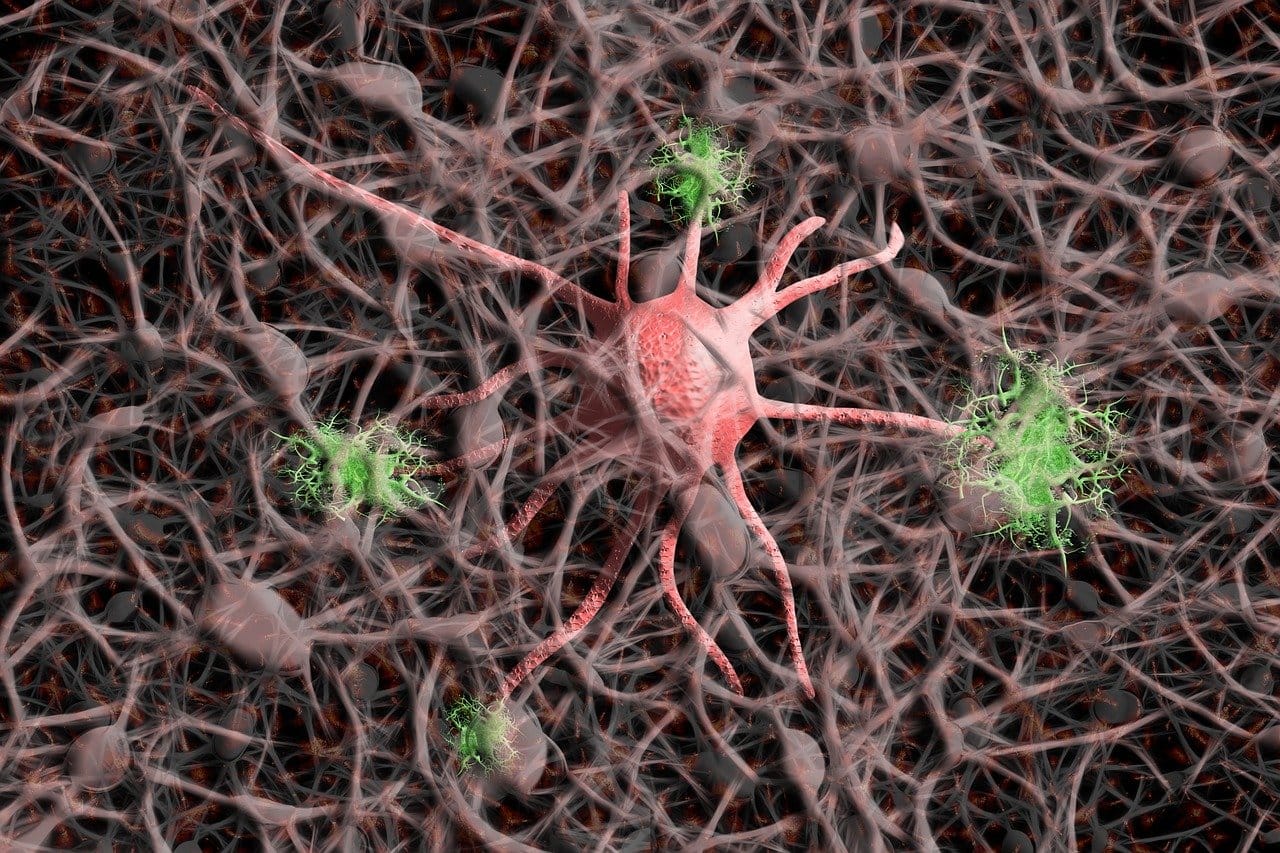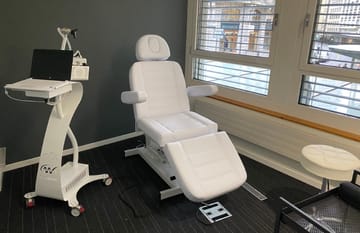Multiple Sclerosis (MS) is a complicated and challenging topic. The disease often starts when you're young, between your 20s and 40s. The disease is also progressive–you don't have a method to reverse the condition yet–and incapacitating over time.
The disease is unpredictable in its course, has symptoms that others can't see from the outside, and is debilitating at many different levels. Both physically, psychologically, and socially, there's a huge impact on a person with MS.
Hence, we need better solutions!
You may ask: "So, is red light therapy good for MS"?
The answer here is "Yes" - there are tons of great studies emerging on this topic. More research is needed as well (as always) on the best light therapy treatment in this case. I'll cover that topic in great detail in this article. The same is true for the best red light therapy devices for MS.
And a whole bunch of other topics!
Are you short on time? Then just read the summary below! Want to understand the big picture and all the details? In that case, read my entire article.
Let's go...
Multiple Sclerosis (MS) is an autoimmune condition (whereby your immune system incorrectly attacks your body's own cells). The main target of that autoimmune attack is the myelin in your nervous system, the white matter that allows for quicker nerve conductivity, among others. With the breakdown of myelin, the overall function of your nervous system goes down. This process leads to lower nerve conductivity, neurological symptoms, and permanent damage. Different MS types exist, each with its own development.
MS risk factors include smoking, a lack of sunlight exposure, viral infections, female sex, and obesity. Right now, MS is irreversible and only deteriorates over time. You can slow down the deterioration, however, with lifestyle and nutrition changes.
Inflammation, in particular that of the nervous system (neuroinflammation), plays a major role in MS. Red light therapy is an ideal candidate to influence that process because it has been shown to decrease excess chronic inflammation across the board.
Right now, human studies on red light therapy for MS are limited but they still show some improvement in muscle function, inflammation, and quality of life. Animal studies that allow researchers to take a deeper dive into the physiology of an animal show additional benefits, such as directly slowing down the damage to the myelin, enhanced sensory and motor function, and lower neuroinflammation.
The recent scientific reviews I've referred to confirm this big picture.
A lot more high-quality research is needed on red light therapy for MS, even though current studies are promising. Nevertheless, I do give some device recommendations later on in this article and I recommend you go extremely slow with treatment and closely monitor your results. By trial and error, you should be able to find a sweet spot and maintain treatment over time.
If you need an introduction to what these terms mean, check the following resources:
- What Is Red Light Therapy?
- Red Light Therapy Explained: Basic Terms Guide
- Start Here - Light Therapy 101 & Buyers Guide
- Red Light Therapy Dosing Chart: The Raw Data From Hundreds Of Studies
- Red Light Therapy Dosing: Why It's Complicated!
- Red Light Therapy Wavelengths Benefits: The Ultimate Guide
- How Often Should You Use Red Light Therapy Explained
These resources should give you a basic understanding of how red light therapy works, and the discussions around it!
Multiple Sclerosis Introduction
First, I'l give you the multiple sclerosis basics. I'll cover reviews in the last 5 years for that introduction - reviews in medicine integrate previous research on a given topic (1; 2; 3; 4; 5; 6; 7; 8; 9; 10; 11; 12; 13). By understanding multiple sclerosis, you'll later be more easily able to understand the role of light therapy for this condition.
Multiple Sclerosis Basics
Multiple Sclerosis (MS) is an autoimmune condition (1). "Autoimmune" here means that your immune system falsely attacks its own cells - so it doesn't correctly differentiate between the "self" and "non-self". Normally, you'll want your immune system focused on invaders such as bacteria and viruses, not your own cells.
In MS, the myelin sheath of your nervous system is attacked (14). These myelin fibers increase nerve conductivity and are one of the hallmarks of what makes humans humans. The myelin sheath is like a highway for the conductivity of your nervous system.
With damage to the brain and spinal cord, damage to the white matter (myelin sheath) leads to lower nerve conductivity and poorer communication between the brain, spine, and the rest of the body. Over time, you can have scar tissue buildup as well (sclerosis), which may lead to permanent nerve damage.
MS is one of the leading neurodegenerative diseases in young adults (1). Both the environment and genetics play a role in the development of the disease. Latitude, so your distance from the equator, as well as vitamin D status, is a major risk factor for MS (15; 16; 17; 18; 19). More on that later - it seems like sunlight exposure is a huge factor in not only MS risk but also countering symptoms.
Diagnosing Multiple Sclerosis And Multiple MS Types
The ability to diagnose multiple sclerosis (MS) has significantly improved over the last few decades, largely due to advancements in MRI technology (1). MRIs are also better interpretable and, therefore, lead to more specialized treatments.
MS diagnosis isn't super easy, however (14)! The issue here is that MS symptoms overlap with other neurological conditions, so extensive analysis is needed. You'll need someone's medical history, for instance, MRI tests, neurological exams, nerve conductivity tests, and potentially lumbar punctures for proper diagnosis (14).
Different MS types also exist. One prominent example here is the Relapsing-Remitting MS (RRMS), which is characterized by high-symptom flare-up periods as well as recovery periods with fewer symptoms. RRMS accounts for approximately 80% of cases (2). Then, there are the progressive forms of MS, such as SPMS and PPMS, that worsen over time.
"PP" here refers to Primary-Progressive, and "SP" refers to Secondary-Progressive (2; 8). The PP deteriorates more gradually over long periods. Within the SP stage, there will be more remissions and relapses (20). About 15% of MS patients have the PP form (2). There's some debate, however, on how to precisely define these MS types, such as the SPMS definition:
"definitive clinical, imaging, immunologic, or pathologic criteria that demarcate the transition from relapsing-remitting MS to SPMS" (8)
Relapses matter in general, however, as patients' health often moves to a lower baseline even though symptoms mostly recover. So it's essential to both detect and manage MS symptoms properly:
Multiple Sclerosis Symptoms
The following list is excellent to understand multiple sclerosis symptoms - the:
"condition manifests with a wide range of neurological symptoms, such as vision impairment, numbness and tingling, focal weakness, bladder and bowel dysfunction, and cognitive impairment." (2)
The same is true for neuropathic pain - a potential MS symptom (13). In short, anything related to the deterioration of nervous system function is the result. What isn't mentioned in the list above is the loss of functional capacity and motor coordination, which I've experienced first-hand as a physical therapist working with patients.
Over time, functional capacity to move is reduced, which leads to problems down the road. If you don't move much anymore or don't have a good ability to move, muscle function will go down, as will bone density, motor coordination, and so forth. And once these areas deteriorate, other aspects of your health are also affected.
Multiple Sclerosis Treatment
So what can you do? The bad news here is that, right now, there is no outright cure. There are treatments, such as Disease-Modifying Therapies (DMTs), pharmaceuticals like steroids, and symptom management strategies that can slow disease progression and improve overall function.
For the best outcome, you'll want early diagnosis and intervention! The longer you wait to diagnose and treat symptoms, the worse the condition generally becomes. MS has a so-called "prodromal period" where you won't have apparent MS symptoms yet, but do have overall health issues.
Examples of symptoms during the prodromal fatigue periods are depression, anxiety, migraines, sleep disturbances, cognitive issues, and more! Outright neurological symptoms will be less present or entirely absent at this point. You'll be in a better place, however, if treatment already starts at this point!
But here's the good part:
"The large portfolio of currently available medications paved the way for personalised therapeutic strategies that will balance safety and effectiveness. Incorporation of cognitive interventions, lifestyle recommendations, and management of non-neurological comorbidities could further improve quality of life and outcomes." (1)
Adopting a healthy lifestyle, including regular physical activity, exercise, and a balanced diet, is crucial for managing MS symptoms (20). The same is true for engaging in cognitively-demanding tasks - these keep your nervous system young and counteract MS symptoms (20).
However, the complete treatment of all symptoms is more complex. Researchers write about that topic:
"The treatment plan for individuals with MS includes managing acute episodes, using disease-modifying agents to decrease MS biological function of MS, and providing symptom relief. Management of spasticity requires physiotherapy, prescription of initial drugs such as baclofen or gabapentin, secondary drug options such as tizanidine or dantrolene, and third-line treatment such as benzodiazepines. To treat urinary incontinence some options include anticholinergic medications such as oxybutynin hydrochloride, tricyclic antidepressants (such as amitriptyline), and intermittent self-catheterization. When it comes to bowel problems, one can try to implement stool softeners and consume a high roughage diet" (4).
Hopefully, you see the complexity of the situation (7)! And then there are new biomedical approaches like stem cell therapy for MS (9). Therapy is also different for younger and older people (10). Medication is also super important as it can prevent and slow down relapses by around 30 - 70% (first-hand).
Each part of the nervous system that's inhibited needs specialized treatment, whether it's your bladder, capacity to move, vision, or so forth!
Multiple Sclerosis Risk Factors
So, how do you avoid MS? Low sunlight exposure and low vitamin D levels, as stated earlier, are MS risk factors. Cigarette smoking is a risk factor as well (20: 25). Avoiding being overweight or obese may help as well, especially once you have MS (6; 21). Being overweight or obese in childhood may already play a role here (23).
Unfortunately, the incidence of MS is still increasing, meaning that a higher percentage of people get the condition worldwide each year (5). Some risk factors are more complex to control, such as head trauma that increases MS risk (22). Sex is also such a variable, with women being affected 2-3 times as frequently as men. Viral infections, such as Epstein-Barr, are another risk factor that's harder to avoid (24).
Next, let's consider the enormously important role of inflammation in MS—a topic I'll return to later when discussing red light therapy in relation to inflammation.
Inflammation’s Role In Multiple Sclerosis
A very active immune system plays a significant role in multiple sclerosis. An inflammatory response is the natural counterpart of that immune system activation (26; 27; 28; 29; 30; 31). I'm considering this topic in more detail because, as you'll see later on, one of red light therapy's main mechanisms is by decreasing systemic inflammation, so that pathway may also explain why red light therapy is fruitful for MS.
So, neuroinflammation - or "nervous system inflammation" - lies at the heart of MS. With the chronic immune response whereby the myelin sheath of the nervous system is attacked, inflammation results. The myelin sheath can be envisioned as the highways of your nervous system, with the highest conductivity. Myelin also acts as a protective sheath around your nerves.
Different parts of the immune system participate in the autoimmune response. For instance, T and B lymphocytes mistakenly attack the myelin. Next up, many pro-inflammatory cytokines, which are messenger compounds, like TNF-alpha, Interleukin-6, and IFN-Gamma, increase inflammation.
With poorer myelin function, nerve cells eventually die. Hence, you'll end up with lesions in the brain and nervous system and get progressive disability. Right now, that process isn't reversible, as I've stated earlier, but can only be slowed down. The most important realization here is that if there is a way to bring the inflammation and the overactive immune response to a halt, you'd make great gains with MS.
So that's the topic I'll explore below:
How Red Light Therapy May Benefit Neurological Health
Right now, Vladimir Heiskanen's Excel Sheet has categorized 8,000+ studies on red light therapy, from which 16 studies are on Multiple Sclerosis (32). I'll divide these studies into animal and in vitro (Petri dish) studies, human studies, and reviews:
Human Studies
First, I want to examine the human studies independently before considering the reviews. There are only five human studies on MS in total as of right now (32):
- The first study investigates muscle function in people with MS (33). This is actually two studies in one publication. The participants used maximum contractions of their muscles in the front of the lower legs (tibialis anterior). Here's the slightly complicated study setup:
"This study consisted of two parts with a randomized double-blind crossover design. In study I, muscle function was assessed in four sessions before and after [red light therapy] in ambulatory pwMS (N = 17, F = 14) as follows: maximal voluntary contraction (MVC) and muscle fatigue of the right tibialis anterior (TA) muscle was compared at baseline and following a two-min submaximal fatiguing contraction. Then, [red light therapy] was administered to the belly of TA muscle at different doses of energy of an active device (40 J, 80 J, 120 J) or placebo. The muscle function assessment was then repeated." (33).
- The good news here is that muscle performance improved and force recovered more quickly when red light therapy was applied. The downside here is that the study does not include clear treatment parameters, such as wavelength or the size of the treated area.
- Then, another exciting study with an interesting setup, whereby one group receives light therapy under the tongue and the other at the radial artery of the forearm (34). The wavelength is 808 nm, and the total treatment area isn't described well. Fatigue wasn't affected in this study, but, there wasn't a clear placebo group either! I would have loved if this study was carried out with much clearer parameters and a control group.
- Next, another 808 nm study (35). This study had the same dosing protocol as the previous study, in terms of treatment location. Here, the levels of Interleukin 10, an anti-inflammatory cytokine (messenger compound), increased, so it's a good outcome!
- Furthermore, one study investigates red light therapy alone, versus red light therapy and magnets, vs magnets alone, vs movement therapy (36). Again, interesting, but I'd rather have seen red light therapy versus placebo! The red light therapy and magnet combination achieved the best result in this study on both functional status and likely quality of life. Positive effects also persisted after treatment ceased. A 650 nm light source was used, but only for spot treatment.
- Lastly, there is a human study that provides very few details (37).
Unfortunately, there isn't much great information here. Overall, there appears to be a positive effect of red light therapy; however, the treatment protocols vary significantly across studies.
Multiple Sclerosis Animal Studies
Since we have very little high-quality human data, I'll review the animal studies on red light therapy for MS. Here's the outcome of those studies:
- First, there's a 660 and 850 nm mouse study (38). Here, inflammation goes down, and sensory and motor deficits improve. Light therapy also had neuroprotective effects, leading to a healthier, more functioning immune system. The light was applied to the belly of the mice and their backs, treating larger areas in this way (39).
- Then, an 808 nm study using 36 J/cm2 as the total dose (40). Demyelination is the result here, which is the main outcome you'd have as that process (losing highly-conductive white matter in the nervous system) is the basis for MS in the first place. The mice received six transcranial (through the skull) light therapy sessions over a period of four weeks. A spot between the eyes was also treated. Here's the very exciting outcome that researchers describe:
"Twenty-four hours after the last laser session, all animals were euthanized, and brains were extracted. Serum was obtained for lactate dehydrogenase toxicity testing. Histomorphological analyses consisted of Luxol Fast Blue staining and immunohistochemistry. The results showed that laser-treated animals presented motor performance improvement, attenuation of demyelination, increased number of oligodendrocyte precursor cells, modulated microglial and astrocytes activation, and a milder toxicity by cuprizone. Although further studies are required, it is suggested that LLLT represents a feasible therapy for demyelinating diseases." (40).
- Next up, a study comparing 660 nm and 904 nm on the spinal cord in mice (41). Neuroinflammation decreased, and the process underlying MS was reduced, which is once again an auspicious and wonderful outcome!
- Furthermore, a 670 nm mice study (42). Here the light protects against stress in the nervous system, such as that created by "Reactive Nitrogen Species" and also improves cell survival in that nervous system.
- Lastly, one more 670 nm mouse study (43). Here's the protocol:
" Mice received 670 nm light or no light treatment (sham) administered as suppression and treatment protocols. 670 nm light reduced disease severity with both protocols compared to sham treated mice. Disease amelioration was associated with down-regulation of proinflammatory cytokines (interferon-γ, tumor necrosis factor-α) and up-regulation of anti-inflammatory cytokines (IL-4, IL-10) in vitro and in vivo." (43).
- Once again, a promising outcome with lower inflammation across the board!
Those are all the existing animal studies on red light therapy for MS currently available. Across the board, there seems to be good benefit for inflammation and overall nervous system health.
I won't go into the in vitro studies as we've got plenty of human and animal studies. In vitro here means "in the glass", which are Petri dish studies.
Lastly, let's consider a few reviews that analyze and integrate extant high-quality studies on a topic:
Red Light Therapy For MS Reviews
Lastly, for this section, let's check what the reviews on red light therapy for MS are saying. Often, there is great commentary in these studies that provides valuable insight.
Let's consider the last four reviews on red light therapy benefits for MS (44; 45; 46; 47).
The first review is based on animal studies and concludes that the "experimental allergic encephalomyelitis" process, similar to MS in humans, gets significantly impeded (44). Here's what researchers write about other underlying processes of MS in the animal studies:
"[Red light therapy] also significantly reduced other parameters such as infiltration of mononuclear cells, [central nervous system] demyelination, apoptosis markers and pro-inflammatory cytokines. However, there was an overall high risk of bias in all of the studies." (44).
So these are great benefits across the board. These benefits only need to be confirmed in human studies!
The second review, based on human studies, has a similar conclusion:
"The reviewed studies showed that [red light therapy] modulates brain markers linked to inflammation, oxidative stress, and apoptosis. Improvements in motor, sensorial, and cognitive functions in MS patients were also observed after [red light therapy]therapy. No study reported adverse effects of [red light therapy]." (45)
Again, as the review states and similar to my conclusion, more research is needed on this topic (45)! The third review, again, has a very similar conclusion:
"[Red light therapy] has positive effects on MS by regulating the inflammatory process, controlling immune cell activity and mitochondrial functions, as well as inhibiting free radicals production which finally leads to a reduction in neurological defects and an improvement in the functional status of patients" (46)
The fourth review concludes that inflammatory processes decrease, and neurons (nervous system cells) exhibit improved regenerative capacity. Again, great outcome!
So all the reviews more or less agree with my assessment and show promising results! Of course, we need more high-quality long-term human studies as I've repeated over and over again but current outcomes are promising and a strong impulse to investigate the topic a lot further!
Does Red Light Therapy Aim For The Underlying Cause of MS?
Yes, red light therapy seems to aim at many of the underlying causes of MS - specifically neurological dysfunction:
- In humans, you'll see muscle function improvement (which is often impaired), as well as anti-inflammatory effects.
- In animal studies, there are more extensive effects observable because it's easier to sacrifice the animals and investigate the nervous system in detail. Here you have lower systemic inflammation (and neuroinflammation), impeded neurodegeneration and demyelination (damage of the myelin white matter that increases conductivity), and better sensory and motor functions. Other benefits exist as well such a improved immune system functioning (which is the main problem in autoimmune diseases!), and the lowering of oxidative stress.
- Reviews generally confirm these effects.
So, yes, red light therapy affects many of the underlying causes of MS! However, as I stated a few times now, more research is needed on this topic to know the exact effects and treatment parameters!
Read more on implementing red light therapy for MS below:
Evidence And Anecdotes On Red Light Therapy For MS
For the goal of personal experience and anecdotes, I highly recommend joining our Facebook group and talking about the topic there. You can use the search function and find some other people who have posted questions there for MS:
You can join for free! And, there's always someone who will answer your questions on red light therapy, autoimmune disease, and MS in general.
Should People With MS Implement Red Light Therapy? If Yes, How?
Yes, I generally support implementing red light therapy for MS. However, I recommend going slow. Simply put, if you've got an autoimmune condition, your ability to tolerate stress will be lower - and red light therapy can be considered a stressor on the body!
So, go slow and monitor your response. Then, slowly increase your exposure over time and keep monitoring your response. If you get results, you can still increase your exposure but if the results ever drop off, you'll have to lower your total dose. If you want to learn more about dosing, check my articles on that topic here:
- Red Light Therapy Dosing Chart: The Raw Data From Hundreds Of Studies
- Red Light Therapy Dosing: Why It's Complicated!
Given the current publications, I would probably recommend using infrared light for multiple sclerosis, either transcranially (through the skull) or through the nose. Here, the Vielight products come to mind:
That video is created by the founder and owner of this website, Alex Fergus. Here's another Vielight video you don't want to miss:
The Vielight devices I recommend for MS are the Neuro Duo and the MIP - the latter provides red light therapy to the bloodstream of the brain directly, via the nose!
Another option is the SunPowerLED that Alex discusses here:
Both options above are likely very suitable for MS. Again, we very decent need more research on this topic. Next up, I think that the bigger red light therapy body panels, which are large and cover the entire body, are a great tool here:
Go very slow at the beginning with these body panels! That's generally the case - build exposure slowly and monitor. The goal here is to maintain treatment over time, as I observe that in many neurodegenerative conditions, the results keep paying off over time. Sometimes, the "inevitable" decline is stalled, for instance, such as with Parkinson's Disease. At other times, such as with Fibromyalgia, huge improvements can be expected and are observed in studies.
Thirdly, I would consider the Chroma devices, especially those with ultraviolet (UV) light. I've not really considered that topic in this article. Alex has reviewed the Chroma Ironforge below:
The device you'd rather get, however, is the D-Light by Chroma. If you get a Chroma D-Light then use discount code ALEX to save.
Future Potential: What Lies Ahead For Red Light Therapy In MS Treatment?
Yes, there are so many questions you could ask regarding red light therapy for MS treatment in the future, such as:
- "How about combining cryotherapy and red light therapy, does this help?"
- "What about red light therapy chronic fatigue if that's paired with MS - do you have any specific protocols?"
- "Should red light therapy for MS patients be universally used or do some people respond better than others?"
To all these questions, and many similar ones, there is no answer right now! Nevertheless, there are some remarkable developments in MS as a whole–examples here are remyelination and neuroregeneration pharmaceuticals, immune modulation, holistic lifestyle and nutrition changes, and so forth. There are even developments in MS and gut health - so I wouldn't be surprised if red light therapy for the gut would help here, in the same way it very likely does for red light therapy for Parkinson's.
The future is bright in that regard!
Conclusion: More Research Is Needed But Careful Trial And Error Experimentation Is Recommended!
Yes, you and I need far more research on red light therapy for MS. Nevertheless, seeing the positive outcomes of the human and especially animal studies, I'm very happy to recommend people start experimenting slowly and with low doses initially with red light therapy for MS.
The future looks good overall for MS. With new therapies emerging and red light therapy perhaps being at the forefront of it–red light therapy has some great benefits so far for other neurodegenerative diseases–hopefully there are more options for people with MS in the years and decades down the road!
Items Mentioned In This Article
- Vielight MIP and Vielight Duo - use discount code ALEX10
- SunPowerLED - use discount code ALEX5
- Red light therapy body panels - click the link to see the video for many discounts for different panels
- Chroma D-Light - use discount code ALEX to save.
This is a post by Bart Wolbers of Lighttherapyinsiders. Bart finished degrees in Physical Therapy (B), Philosophy (BA and MA), Philosophy of Science and Technology (MS - with distinction), and Clinical Health Science (MS), has had training in functional medicine, and is currently chief science writer.
Found This Interesting? Then You Might Like:
- Discount Codes, Deals & Recommendations - Red Light Therapy
- Red Light Therapy Wavelengths Benefits: The Ultimate Guide
- Red Light Therapy For Upgrading Your Brain Health
- Red Light Therapy For Migraines 101: Why The Research Is Super Promising!
- Red Light Therapy For Sleep: The Science of Sweet Dreams
- Red Light Therapy For Neuropathy: The Promising Science
- Does Vielight Work? A Close Look At The Spectacular Vielight Science
- Red Light Therapy For Depression: A Potential Solution
- Red Light Therapy For Epilepsy: Current Science Explained
- Red Light Therapy For Parkinson's Disease: A Hopeful Strategy!









